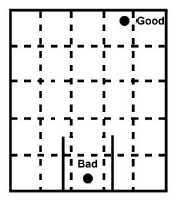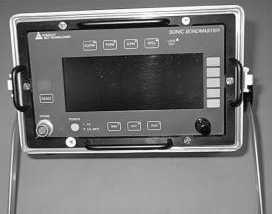T.O. 33B-1-1
5-79
Figure 5-79. Mechanical Impedance Analysis Display.
5.4.6.5
Eddy-Sonic Method.
Since this method is based on the generation of eddy currents in the test part, it will work only on metal structures. The
instrument sends electrical pulses, with frequencies in the low kilohertz range, to a coil in the probe. The resultant
pulsating magnetic field produces eddy currents in the part; the eddy currents cause the part to vibrate, and a
microphone on the axis of the coil detects the sonic vibrations. Unbonds cause changes in the vibrational response of
the part. The detected changes produce an indication on a meter or an LED array. The probe usually has a mechanical
lift-off adjustment that sets the air gap between the coil and the test surface to minimize the noise produced by probe
scanning. This method works best on metallic honeycomb structures with thin skins (0.062 inch or less). Other
methods do as well on such configurations, and because the eddy-sonic is rather limited in its application, it is not
commonly used.
NOTE
For a reliable bond inspection, the inspection surfaces of the test part must be free of
loose paint and foreign matter.
CAUTION
Gradual changes in indications on an instrument display should be evaluated to see
if the part thickness is changing. If the part thickness has changed, recalibration is
required. When possible, scanning should be performed in directions of constant
thickness.
Figure 5-80. Typical Multiple Mode Bond Tester.



